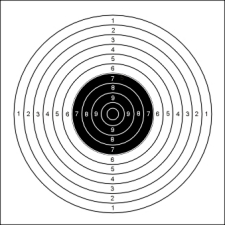The name of this match refers to the method of priming of the cartridge. In a rimfire round, the priming compound is located, as the name implies, in the crushable rim of the cartridge case. In a centre fire cartridge there is a removable primer located in the centre of the base of the cartridge case. This permits the cases to be reloaded by the shooter hence saving on costs. The cartridges fire a wadcutter lead projectile at fairly low pressure to achieve a muzzle velocity of approx 750 feet per second.
Centre fire pistols have bores of between .30 and .38 calibre with the most common being the .32 and the .38. These pistols can be either semi-automatic or revolvers.
The match consists of two distinctly different stages. The first involves 30 shots of precision shooting on the 50m International Precision target at a range of 25 metres. Six series of five shots are fired each series of 5 minutes duration. In the second stage, 30 shots are fired at a Rapid Fire target which is exposed for 3 seconds only and faced away for 7 seconds. Again, six series of five shots are fired in this stage.
Total score for the match is 600.
The match can be participated in by men and women but is generally more popular with men. The women's sports pistol match is identical in every way to this match except that the pistol used is of .22 calibre.
Reloading of centre fire cartridges gives shooters the opportunities to develop loads which can provide a very high degree of accuracy. |












